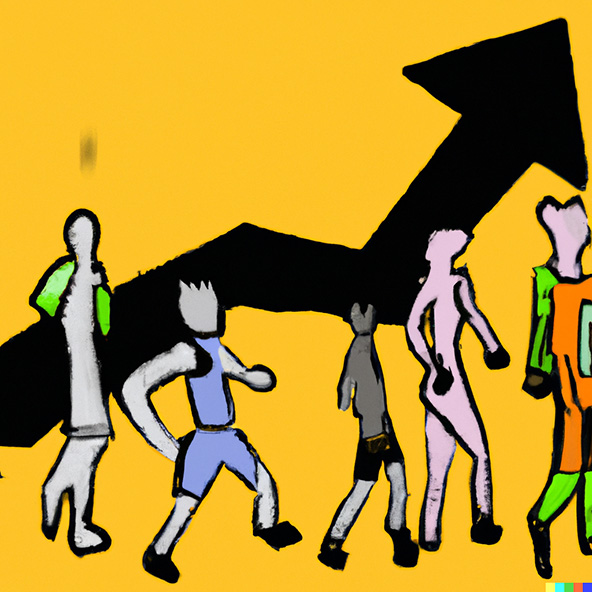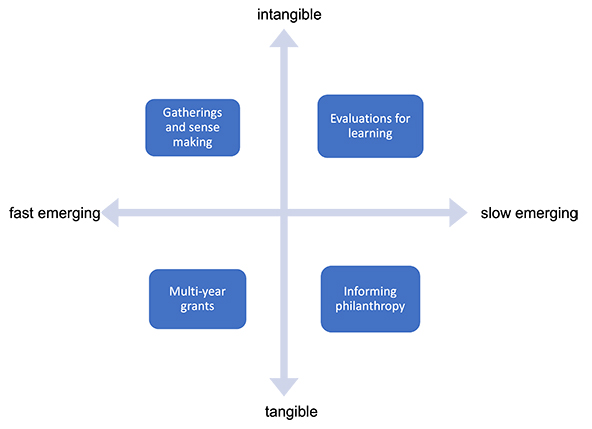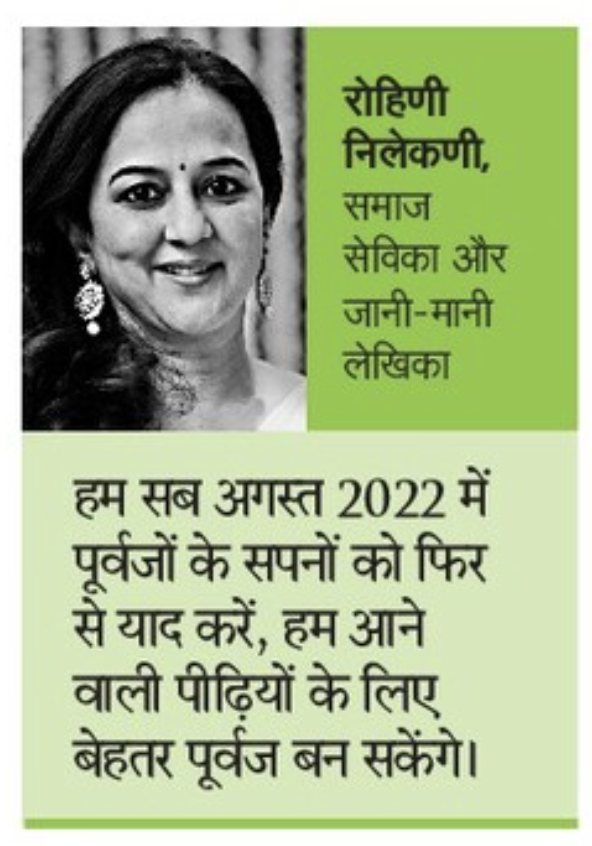कुछ महीने पहले, मेरी टीम और मैं हमारे कार्यालय के ठीक बाहर सफाई करने के लिए एक त्वरित स्वैच्छिक अभियान में शामिल हुए। अग्ली इंडियन (Ugly Indian), एक गैर-लाभकारी संस्था जो आम लोगों को नागरिक गौरव विकसित करने के लिए प्रेरित करती है, के उत्साही स्वयंसेवी अरुण पई ने हमें दिखाया कि कैसे हम अपनी आस्तीन मोड़कर कोई भी उपकरण उठाएं, जो हमें मिल जाए, और मलबे से भरे स्थान को नागरिक गौरव की चीज़ में बदल दें।
हमारे पड़ोसी मदद करने के लिए आए। राहगीरों में एक सुरक्षा गार्ड और एक घरेलू कामगारिन, जो काम पर जा रही थी, भी शामिल हुए। जब हमने काम खत्म किया और चटक रंग व रंगोली आकृतियों से सुसज्जित अपने कृत्य की प्रशंसा करने के लिए ज़रा पीछे हटकर खड़े हुए, हम में एक खुशी-भरा कॉमरेडाना भाव पैदा हुआ, जिसका वर्णन करना मुश्किल है। हम एक फोटो के लिए साथ खड़े हुए, हमने उस जगह को साफ रखने का वादा किया और फिर अरुण, जिन्होंने इस स्वैच्छिक कार्रवाई को शुरू किया था, को धन्यवाद दिया।
मेरे लिए, यह पिछले वर्ष का एक प्रमुख आकर्षण था, क्योंकि यह महामारी-प्रेरित स्वयं सेवा के उभार की बहुत ही महत्वपूर्ण कहानी को जारी रखता है। दसियों लाख लोग पूरी तरह अजनबियों के प्रति नेकी के कार्य करने निकल पड़े थे। मेरा मानना है कि इस अनुभव ने हमारे भीतर बुनियादी रूप से कुछ बदल दिया है, हमें यह शिद्दत से याद दिलाता है कि मानव होने का मतलब क्या है। अब चुनौती यह है कि अधिक सामान्य समय में भी महामारी के बाद की लौ को कैसे जीवित रखा जाए।
मेरे परिवार में स्वयंसेवा को हमेशा सर्वोच्च व्यक्तिगत नैतिकता (personal ethic) के रूप में स्थान दिया गया है। मेरे दादा, बाबासाहेब सोमन ने वकील के रूप में अपनी आजीविका छोड़ दी थी ताकि वे 1917 के चंपारण सत्याग्रह में गांधीजी के स्वयंसेवकों के लिए आह्वान के सबसे प्रथम उत्तरदाता बन सकें। उनके लिए, यह एक आनंददायक कर्तव्य था। हमारे लिए, यह एक अनुस्मारक है कि हम सभी के पास अपना समय, और खुद अपने को उपहार स्वरूप प्रस्तुत करने की क्षमता है। “स्वयंसेवी ” के लिए भारतीय भाषाओं में कोई सटीक पर्याय नहीं है, जो फ्रांसीसी “वोलंटेयर” (“volontaire”) से आया है, जिसका अर्थ ‘स्वेच्छा से’ है, हालांकि अक्सर “स्वयंसेवक” शब्द का प्रयोग किया जाता है। एक सामान्य जीवंत भावना की खोज करने के लिए जो दोनों के बीच पुल का काम करे, शायद हम ” यूबांटू” शब्द का उपयोग कर सकते हैं, न्गुनी बांटू शब्द जो संक्षेप में एक सार्वभौमिक सत्य को प्रकाशित करता है – “मैं हूं क्योंकि आप हैं”। इसलिए यदि मैं आपके लिए अपने आप को देता हूं, तो मैं सार्वजनिक भलाई को भी बढ़ा रहा होता हूं, और मुझे भी एक नागरिक के रूप में इसका लाभ मिलता है।
सेवा, उबांटु, स्वेच्छावादिता (volunteerism) उतनी ही पुरानी है जितना कि मनुष्य। चर्चित तौर पर मार्गरेट मीड ने घोषित किया कि मानव सभ्यता का पहला संकेत एक प्राचीन कंकाल में स्वस्थ हुआ फीमर था, क्योंकि इसका मतलब था कि कुछ प्राचीन मनुष्यों ने वास्तव में स्वेच्छा से एक अन्य आदिवासी की देखभाल की थी, और उसे मरने के लिए नहीं छोड़ा था, जैसा कि जानवरों की दुनिया में एक सामान्य घटना हुआ करती थी। यह भाव अभी भी हम सभी में प्रज्वलित है। संयुक्त राष्ट्र के स्वयंसेवकों का दावा है कि हर साल विश्व स्तर पर 1 अरब लोग स्वयंसेवा करते हैं।
मुझे ठीक से नहीं पता कि वे स्वयं सेवा को कैसे परिभाषित करते हैं, लेकिन यह अभी भी पूरी मानव आबादी का 1/8वां हिस्सा है। सोचिए अगर हर एक ने दूसरे को प्रेरित किया तो क्या होगा। यह इसे एक चौथाई (1/4) आबादी बना देगा और यदि वे सिर्फ एक-एक और को प्रेरित करते हैं, तो इसका मतलब होगा कि दुनिया की आधी आबादी अपने जीवन का एक हिस्सा, छोटा ही सही, इस नाजुक ग्रह में भलाई बढ़ाने के लिए कुछ कार्य करने हेतु लगाने के लिए प्रतिबद्ध है।
अधिक- से-अधिक स्वयंसेवा को समर्थन देना महत्वपूर्ण है। यह समाज को मजबूत करता है, यह लोकतंत्र को ही शक्ति प्रदान करता है। यदि लोकतंत्र जनता का, जनता के द्वारा और जनता के लिए है, तो जनता के कार्यों का भी मूलभूत महत्व है। यह चुनावी लोकतंत्र से कहीं आगे जाता है, मतदान करने वाले और कर चुकाने वाले नागरिकों के रूप में संतुष्ट रहने से कहीं आगे जाता है। इसका मतलब उस अच्छे समाज का सह-निर्माण करना जिसकी हम सभी लालसा रखते हैं, ऐसी आज़ादी जिसे हम खोना नहीं चाहते, सुशासन जिसे हम मानकर नहीं बैठ सकते। इसका अर्थ है अपने समय, अपनी प्रतिभा, अपने संसाधनों को लेकर उन लोगों तक पहुंचना जो हमसे अधिक कमजोर हैं। यदि शाश्वत सतर्कता स्वतंत्रता की कीमत है, तो शायद शाश्वत सहानुभूति एक अच्छे समाज की कीमत है।
हमने अभी-अभी अपने स्वराज्य के 75 वर्ष पूरे किए हैं। लेकिन यदि स्वयंसेवा की शक्ति न होती तो हम में से कोई भी स्वतंत्र राष्ट्र के गर्वित नागरिकों के रूप में इतने आराम से नहीं बैठा होता। हमारे ऐतिहासिक स्वतंत्रता संग्राम, हमारे अद्वितीय सत्याग्रह में दसियों लाख लोगों ने स्वेच्छा से भाग लिया। आज के भारत में भी, ऐसे सैकड़ों संगठन हैं जो ऐसे लाखों स्वयंसेवकों पर निर्भर हैं, जो तन लगाकर और दिल से लोगों को देते हैं।
कई तो आस्था-आधारित हैं, कई विचारधारा-आधारित हैं। वे हर क्षेत्र, हर पेशे, हर वर्ग के लोगों को अपनी ओर आकर्षित भी करते हैं। किसी को भी आर्थिक पारिश्रमिक नहीं मिलता। जैसा कि शेरी एंडरसन ने कहा, “स्वयंसेवियों को भुगतान नहीं मिलता है, इसलिए नहीं कि वे बेकार हैं, बल्कि इसलिए कि वे अनमोल हैं।” वे सभी दुखों को दूर करने, संस्थानों का निर्माण करने और आपदाओं का प्रतिकार करने के लिए अविश्वसनीय कार्य करते हैं।
लेकिन क्या हम नागरिकों के एक ऐसे राष्ट्रीय आंदोलन की कल्पना कर सकते हैं जो आस्थाओं,विचारधाराओं और संकीर्ण पहचानों से परे हो? क्या यह मानवतावाद का उच्चतम रूप होगा? आई वालंटियर(I Volunteer),भूमि(Bhumi), मेक ए डिफरेंस (Make a Difference)आदि जैसे संगठनों ने हजारों युवाओं को एकजुट किया है,जो मानते हैं कि जब तक वे ऐसे समुदायों का निर्माण करने में मदद नहीं करते जो हर परिस्थिति का मुकाबला करने लायक मजबूत हों, भविष्य की राह तय करना कठिन होगा। अपने उद्देश्य के एक प्रदर्शन में,“हमारा स्टेशन,हमारी शान” के बैनर तले 25,000 स्वयंसेवी एक साथ आए और उन्होंने 7 दिनों में 40 रेलवे स्टेशनों को रंग दिया! ! इससे `7 करोड़ की बचत हुई, लेकिन इससे उत्पन्न सामुदायिक गौरव अथाह था।
फिर भी, इन सभी अद्भुत स्वयंसेवियों को समर्थन की आवश्यकता है। मैं जहां भी जाता हूं, लोग मुझसे पूछते हैं, “मैं कैसे मदद कर सकता हूं?” और मेरे पास उनके लिए कोई आसान जवाब नहीं होता। हमें स्वयंसेवी अवसरों की खोज को बहुत आसान बनाने की आवश्यकता है। लेकिन वह परोपकारी पूंजी (philanthropic capital)और प्रतिबद्धता की मांग करता है। महामारी ने स्वयंसेवा की शक्ति को उजागर किया है। अब, इसे बनाए रखने के लिए, यहाँ इस देश के धनवानों का आह्वान करते हैं, जिनमें से कई इन पन्नों को पढ़ते हैं। आइए हम सभी भारत में स्वयंसेवीवाद का समर्थन करने के लिए अपने परोपकारी पोर्टफोलियो का एक हिस्सा लगा दें। आइए हम भी अपना समय स्वेच्छा से दें। साक्ष्य बताते हैं कि यह अधिक उदार और अधिक प्रभावी परोपकार के लिए माहौल बनाता है। लेकिन, सबसे महत्वपूर्ण बात यह है कि यह हमें उबांटु के विचार को अपनाने में मदद करता है।
(लेखिका रोहिणी नीलेकानी फिलैंथ्रॉपीज की चेयरपर्सन हैं। उनका यह लेख इकोनॉमिक टाइम्स में अंग्रेजी में प्रकाशित हुआ था जिसका अनुवाद महिला एक्टिविस्ट कुमुदिनी पति ने किया है।)




